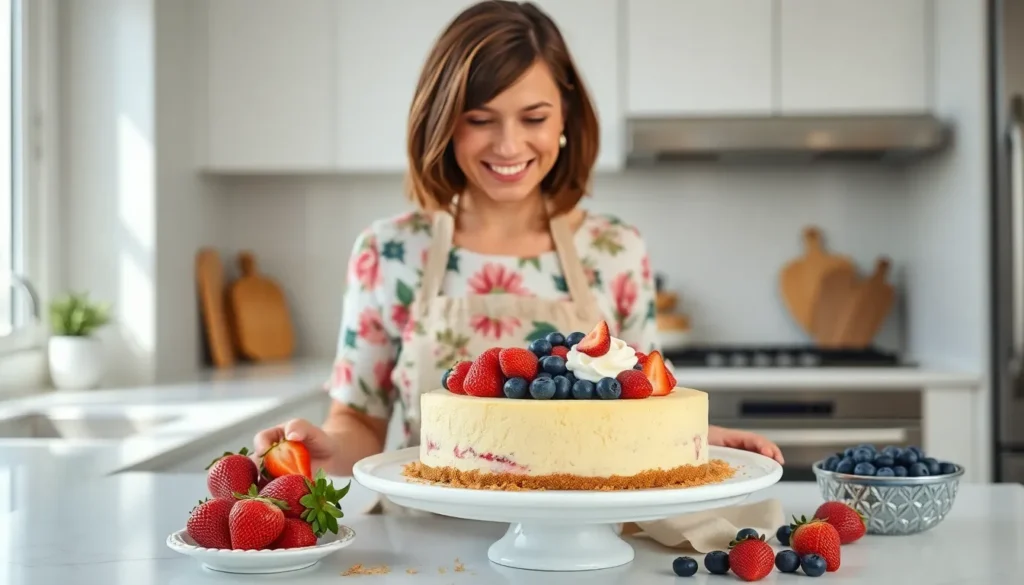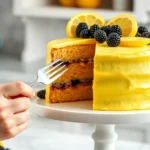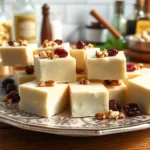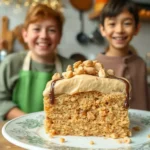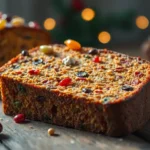We’ve all been there – craving that rich, creamy cheesecake but not wanting to commit to a full-sized dessert that’ll tempt us for days. That’s where small batch cheesecake becomes your perfect solution. This scaled-down version delivers all the indulgent satisfaction of traditional cheesecake without the overwhelming leftovers.
Small batch baking has revolutionized how we approach desserts, and cheesecake is no exception. With just a few simple ingredients and basic techniques, you can create individual portions or a mini cheesecake that serves 4-6 people perfectly. The beauty lies in the control – you get to enjoy fresh cheesecake without the commitment of storing a massive dessert.
Our foolproof small batch cheesecake recipe ensures you’ll achieve that signature silky texture and tangy-sweet flavor every single time. Whether you’re cooking for two or simply practicing portion control, this approach makes homemade cheesecake accessible for any occasion.
Why Make Small Batch Cheesecake
Small batch cheesecake offers the perfect solution when we want to indulge without committing to a full-sized dessert. Traditional cheesecakes serve 12-16 people and can overwhelm smaller households with leftovers that lose their creamy texture after several days in the refrigerator.
We love how small batch baking lets us enjoy fresh cheesecake without waste. A mini cheesecake serves 2-4 people perfectly and disappears before it has time to lose its silky consistency. This approach works especially well for couples or small families who want restaurant-quality dessert at home.
Control over ingredients becomes another major advantage when we make smaller portions. We can experiment with premium cream cheese or unique flavor combinations without the financial commitment of a large recipe. Testing new techniques like graham cracker alternatives or fruit toppings costs less when we work with smaller quantities.
Time efficiency makes small batch cheesecake appealing for busy schedules. These individual portions bake faster than full-sized versions and cool more quickly. We can have fresh cheesecake ready in about half the time of traditional recipes.
Portion control naturally happens when we bake smaller quantities. Instead of facing temptation from a large cheesecake sitting in our refrigerator we create just enough for immediate enjoyment. This method supports our health goals while still satisfying dessert cravings.
Perfect occasions emerge for small batch cheesecakes throughout the year. Date nights become more special with individual desserts. Dinner parties for close friends feel more intimate when each guest receives their own perfectly portioned treat. We can even make multiple flavor variations in the same time it takes to prepare one large cheesecake.
Equipment Needed

Creating our small batch cheesecake requires exact tools that ensure perfect results every time. We need the right equipment to achieve that signature creamy texture and professional presentation that makes this dessert so irresistible.
Essential Baking Equipment
Our 6-inch springform pan serves as the foundation for the perfect small batch cheesecake. This size creates ideal portions for 2-6 people while maintaining the proper depth for that classic cheesecake structure. We can substitute a 7-inch pan if we prefer a thinner profile, though the 6-inch option delivers the most traditional results.
Mixing Tools
We recommend using either a food processor or hand mixer for preparing both our crust and cheesecake batter. These tools ensure our cream cheese reaches the smooth consistency essential for preventing lumps in our final product. The food processor works particularly well for breaking down graham crackers or cookies for our crust base.
Water Bath Setup
Our roasting pan becomes crucial when we choose the water bath baking method. This technique helps maintain consistent moisture levels and prevents those unsightly cracks that can ruin our cheesecake’s appearance. We pair this with a large pot or kettle for boiling the water that fills our roasting pan.
Additional Considerations
| Equipment | Purpose | Alternative Options |
|---|---|---|
| 6-inch springform pan | Primary baking vessel | 7-inch pan for thinner results |
| Food processor | Smooth batter mixing | Hand mixer works effectively |
| Roasting pan | Water bath container | Any large, deep pan |
| Large pot/kettle | Water heating | Any suitable water heating method |
These tools work together to create the controlled environment our small batch cheesecake needs to develop its signature texture and flavor profile.
Ingredients

Our small batch cheesecake requires just a handful of quality ingredients that create rich decadent flavor. We focus on premium full-fat ingredients to achieve the silky texture that makes this dessert irresistible.
For the Crust
- ½ cup graham cracker crumbs
- 2 tablespoons unsalted butter, melted
- Oreo cookies or other cookie varieties (optional substitution for graham crackers)
For the Cheesecake Filling
- 8 ounces full-fat cream cheese (1 standard brick), at room temperature
- ¼ to ⅓ cup granulated sugar (adjust based on preferred sweetness level)
- 1 large egg, at room temperature
- 1 teaspoon vanilla extract
- 1 teaspoon fresh lemon juice (optional for enhanced tang)
For the Topping (Optional)
- 4 ounces additional cream cheese for extra creamy topping
- ¼ cup sour cream for added tang and creaminess
- Fresh berries for natural sweetness and color
- Fruit compote for gourmet presentation
- Chocolate sauce for rich indulgence
- Whipped cream for light finishing touch
We recommend using full-fat cream cheese without xanthan gum or guar gum additives for the smoothest possible texture. Room temperature ingredients blend more easily and create a perfectly smooth batter without lumps.
Instructions
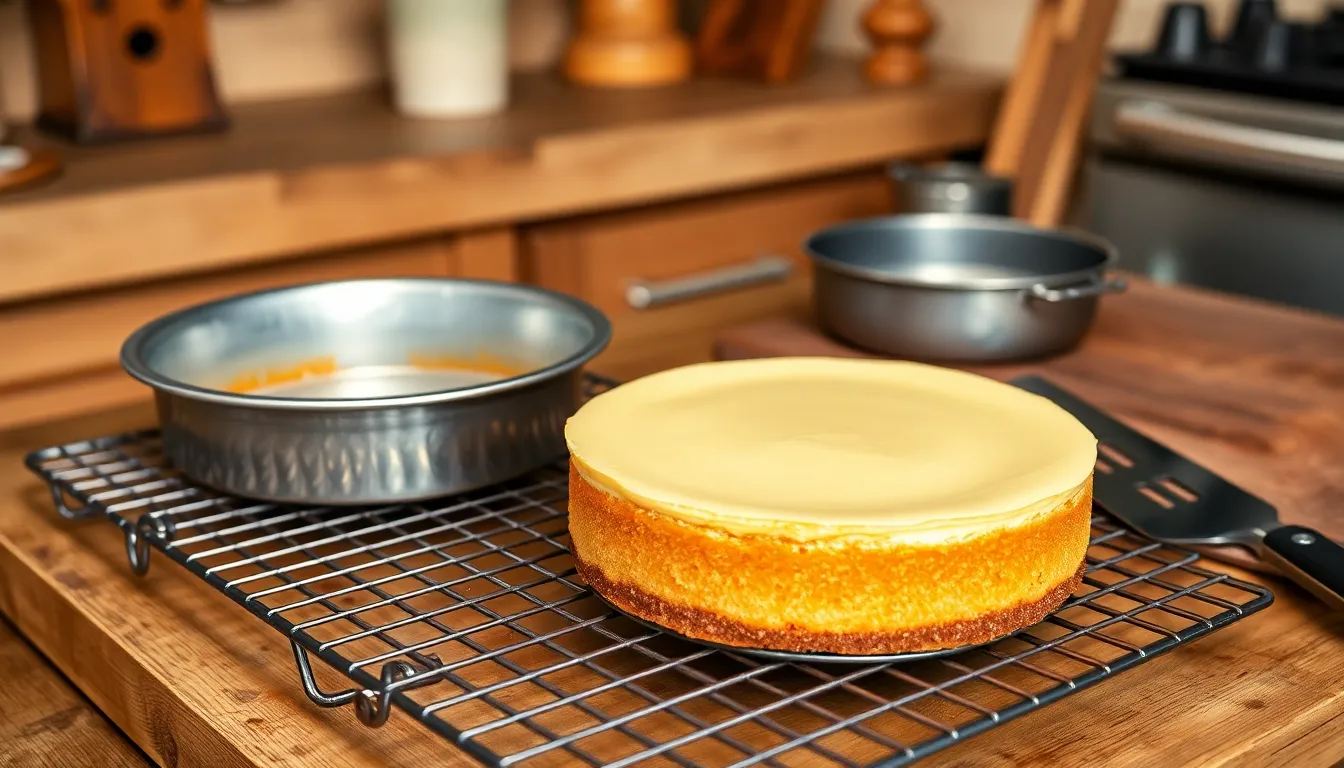
Follow these detailed steps to create your perfect small batch cheesecake. We’ll guide you through each stage to ensure smooth preparation and flawless results.
Prep the Pan
Choose a 6-inch springform pan for the ideal portion size or line a muffin tin with paper liners for individual mini cheesecakes. Preheat your oven to 325°F (163°C) and position the rack in the lower third for even heat distribution. This setup ensures proper baking conditions for our small batch dessert.
Make the Crust
Combine graham cracker crumbs with melted butter in a bowl until the mixture resembles wet sand. For a shortbread variation, mix unsalted butter with light brown sugar, flour, and optional cinnamon. Press the mixture firmly into the bottom of your prepared pan or individual liners, creating an even layer. Bake at 350°F (175°C) for 5-7 minutes to set the crust, then let it cool completely while you prepare the filling.
Prepare the Filling
Beat room temperature cream cheese with sugar and cornstarch until completely smooth, scraping the bowl sides as needed. Add vanilla extract and sour cream or heavy whipping cream for richness, mixing until well incorporated. Include eggs one at a time, beating just until combined to prevent overbeating, which can cause cracks during baking. Optionally, add a squeeze of lemon juice for bright flavor balance.
Bake the Cheesecake
Pour the smooth filling over your cooled crust, spreading it evenly to the edges. Bake at 325°F for approximately 1 hour for a 6-inch cheesecake or 22-25 minutes for mini versions. The cheesecake is ready when the edges appear set, the center has a slight wobble, and the internal temperature reaches 150°F. Avoid opening the oven door frequently during baking to maintain consistent temperature.
Cool and Chill
Allow the cheesecake to cool to room temperature in the pan without rushing the process. Transfer to the refrigerator and chill for several hours or ideally overnight before serving. This extended cooling time allows the texture to firm properly and the flavors to develop their full richness.
Directions for Perfect Results
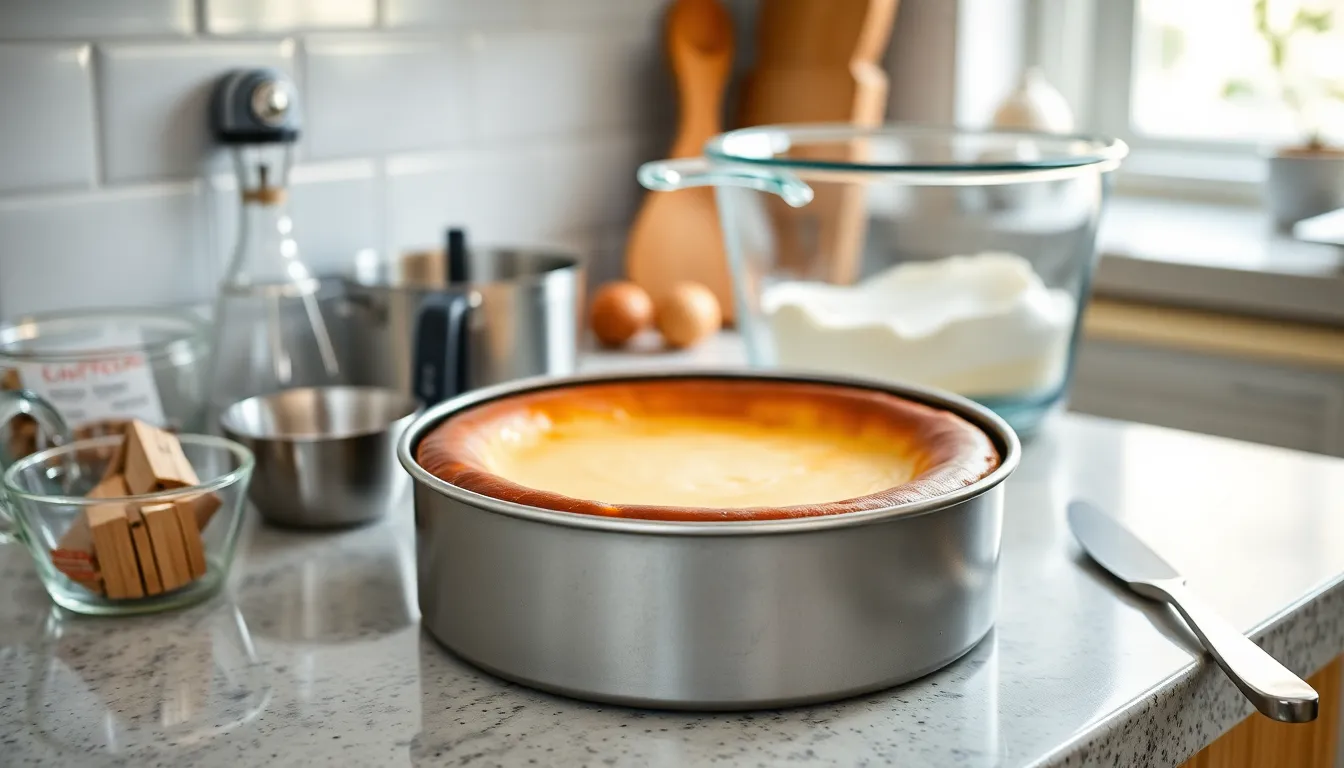
Mastering the perfect small batch cheesecake requires attention to key details that ensure success every time. We’ll guide you through the essential techniques that guarantee a silky smooth texture and prevent common issues.
Temperature Tips
We recommend baking your small batch cheesecake at 325°F to 350°F for optimal results. The moderate temperature allows the custard to set gently without curdling or overcooking the edges.
For 6-inch cheesecakes, we suggest using a water bath method to maintain consistent moisture throughout the baking process. Place your springform pan inside a larger roasting pan and fill it halfway with hot water before placing it in the oven.
Allow all ingredients to reach room temperature before mixing. This crucial step ensures the cream cheese blends smoothly with other components and prevents lumps from forming in your batter.
Prevents Cracks
We emphasize mixing the batter only until ingredients are just combined, particularly after adding eggs. Overmixing incorporates excess air that can cause cracks during baking and cooling.
Gently tap your cheesecake pan on the counter several times before baking to release air bubbles trapped in the batter. This simple technique significantly reduces the likelihood of surface cracks.
Cool your cheesecake gradually by turning off the oven and leaving the door slightly ajar for about an hour. This slow cooling process prevents sudden temperature changes that commonly cause cracks to form across the surface.
Testing for Doneness
We look for a slight jiggle in the center when the pan is gently shaken to determine if our cheesecake is properly baked. The edges should appear set while the center remains slightly wobbly.
For mini cheesecakes, we check for an internal temperature of 150°F using an instant-read thermometer. Insert the thermometer into the center of one cheesecake to ensure accurate readings.
Baking times vary based on size, with mini cheesecakes requiring 22-25 minutes at 325°F. Larger 6-inch versions need additional time, typically 35-45 minutes depending on your oven’s characteristics.
Flavor Variations
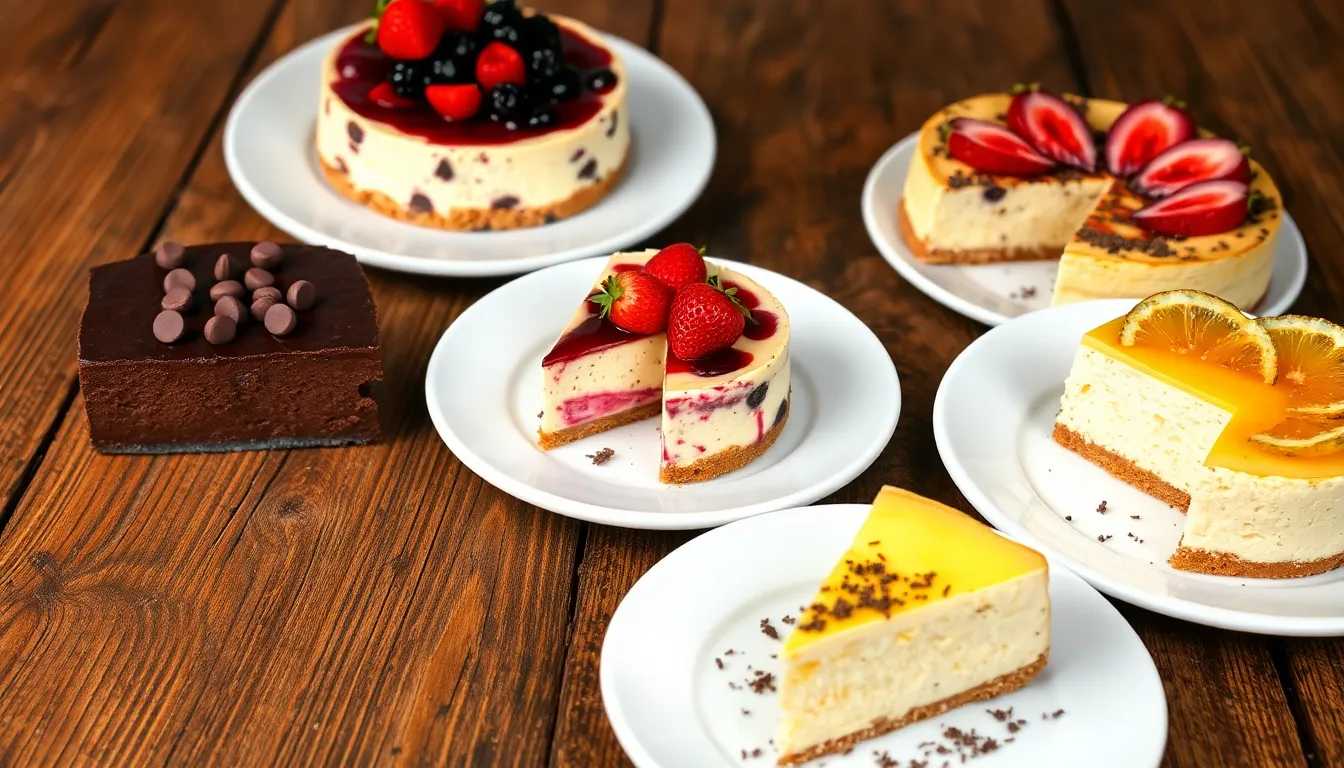
Small batch cheesecakes offer endless opportunities to experiment with exciting flavors without committing to a full-sized dessert. We can transform our basic recipe into decadent variations that satisfy different taste preferences and occasions.
Chocolate Small Batch Cheesecake
Transform your cheesecake into a chocolate lover’s dream by incorporating rich cocoa flavors into the batter. We add 1/4 cup unsweetened cocoa powder to the cream cheese mixture along with 2 tablespoons melted dark chocolate for an intensely chocolatey base. Beat the cocoa powder thoroughly with the cream cheese to eliminate any lumps before adding the remaining ingredients.
Enhance the chocolate experience by folding 1/4 cup mini chocolate chips into the finished batter just before pouring it into the prepared crust. The chips create delightful pockets of texture throughout each bite. Top the cooled cheesecake with chocolate shavings or a drizzle of melted chocolate for an elegant presentation that showcases the rich flavor profile.
Consider using an Oreo cookie crust instead of graham crackers to complement the chocolate filling perfectly. Crush 15 Oreo cookies with their cream filling intact and mix with 2 tablespoons melted butter for a cookies and cream foundation.
Berry Swirl Version
Create stunning visual appeal and bright flavor bursts by incorporating berry compote into your cheesecake batter. We prepare a simple berry mixture by combining 1/2 cup fresh or frozen berries with 2 tablespoons sugar and 1 teaspoon lemon juice in a small saucepan. Cook the mixture over medium heat for 5-7 minutes until the berries break down and create a thick jam-like consistency.
Pour the prepared cheesecake batter into the crust and dollop spoonfuls of the cooled berry compote on top. Use a knife to gently swirl the compote through the batter in a figure-eight pattern to create beautiful marbled effects throughout the cheesecake. Avoid overmixing to maintain distinct berry streaks that add visual interest.
Strawberry and raspberry work exceptionally well for this variation due to their natural tartness that balances the rich cream cheese. Fresh blueberries also create an appealing purple swirl pattern that looks particularly elegant when served at dinner parties.
Lemon Small Batch Cheesecake
Brighten your cheesecake with zesty citrus flavors that provide a refreshing contrast to the rich cream cheese base. We incorporate 2 tablespoons fresh lemon juice and 1 tablespoon finely grated lemon zest into the filling mixture after beating the cream cheese and sugar. The lemon zest adds aromatic oils that intensify the citrus flavor throughout each bite.
Add an extra tablespoon of sugar to balance the tartness from the lemon juice and maintain the perfect sweet-tangy harmony. Fresh lemon juice works significantly better than bottled varieties because it provides brighter acidity and more complex flavor notes that complement the creamy texture.
Top the finished cheesecake with candied lemon slices or a dollop of lemon curd for an elegant presentation that reinforces the citrus theme. We can also add a thin layer of lemon glaze made from powdered sugar and fresh lemon juice for extra visual appeal and concentrated flavor.
Storage Instructions
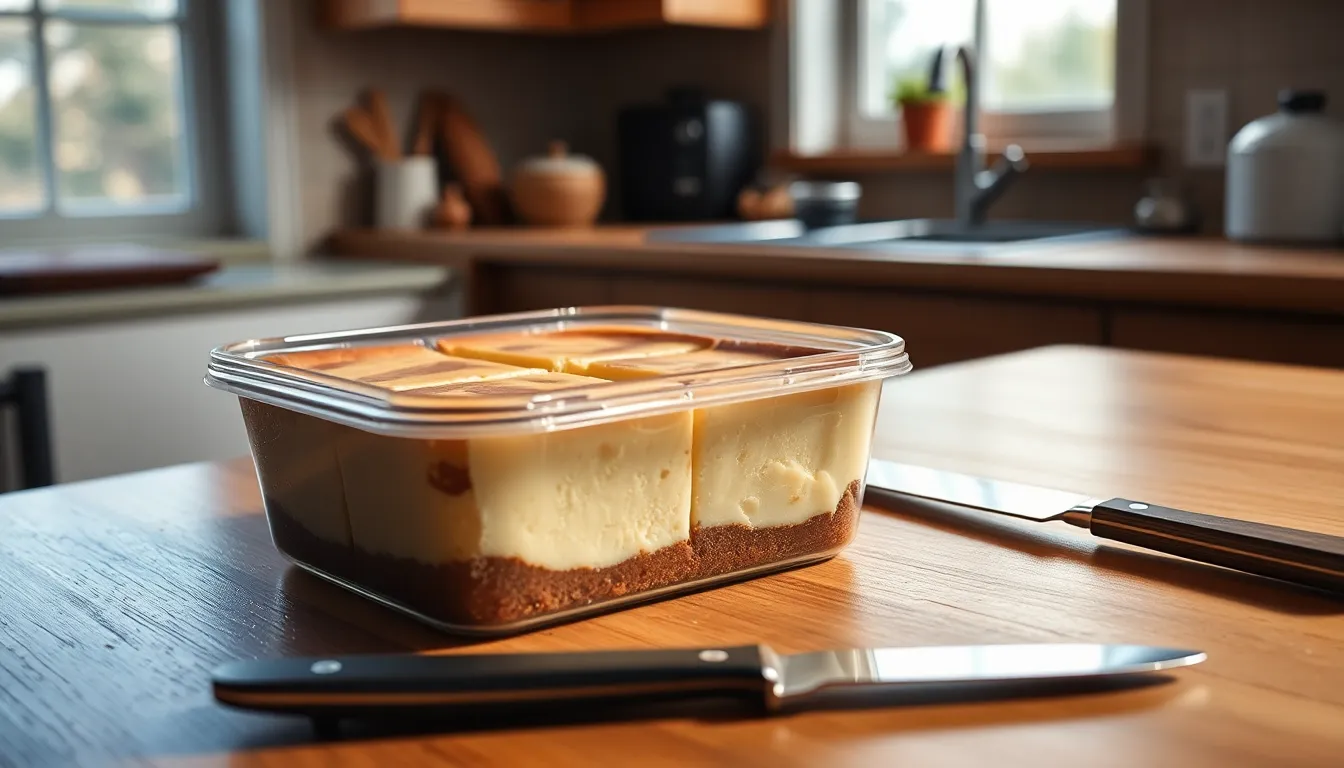
Proper storage ensures our small batch cheesecake maintains its silky texture and rich flavor for maximum enjoyment. We always begin by allowing the cheesecake to cool completely at room temperature before refrigerating. This cooling process prevents condensation from forming and helps avoid unsightly cracks while allowing the texture to set properly.
Refrigeration Requirements
Once our cheesecake reaches room temperature, we transfer it to the refrigerator immediately. The cheesecake needs at least 4 hours of chilling time before serving to solidify the texture and enhance the flavors. We recommend storing the dessert in an airtight container to maintain freshness and prevent it from absorbing odors from other foods in the refrigerator.
For cheesecake bars, we arrange them in a single layer or separate each piece with parchment paper to prevent sticking. Our small batch cheesecake stays fresh in the refrigerator for up to 4-5 days when stored properly in an airtight container.
Long Term Storage Options
| Storage Method | Duration | Container Type |
|---|---|---|
| Refrigerator | 4-5 days | Airtight container |
| Freezer | Up to 3 months | Plastic wrap + freezer-safe container |
We can extend storage life by freezing individual slices or bars for longer periods. First, we wrap each piece tightly in plastic wrap, then place them in a freezer-safe container. Frozen cheesecake maintains quality for up to 3 months and should be thawed in the refrigerator before serving.
Preventing Quality Loss
Exposure to air causes our cheesecake to dry out or form an unappetizing crust on the surface. We always cover the dessert tightly with plastic wrap or store it in a sealed container to avoid moisture loss. The key to maintaining optimal texture lies in keeping the cheesecake protected from air exposure throughout the storage period.
We remove the cheesecake from refrigeration only when ready to serve to retain maximum freshness and that perfect creamy texture we worked so carefully to achieve.
Make-Ahead Tips

Preparing our small batch cheesecake ahead of time transforms busy entertaining into a stress-free experience. We can tackle various components at different stages to ensure our dessert is ready when we need it.
Advance Crust Preparation
Our graham cracker crust benefits from advance preparation and can be made up to 24 hours before we plan to bake the cheesecake. Simply press the crust mixture into our prepared pan and bake as directed. Once cooled completely, we cover the pan tightly with plastic wrap and store it at room temperature. This approach allows the crust to set properly while saving us valuable time on the day we plan to serve our dessert.
Filling Components Ready to Go
The cheesecake filling can be prepared and stored separately for up to one day before we assemble and bake our dessert. We mix all filling ingredients according to our recipe, then transfer the smooth batter to an airtight container and refrigerate. When we’re ready to bake, we simply pour the chilled filling over our prepared crust and proceed with baking instructions.
Essential Ingredient Preparation
Room temperature ingredients create the smoothest batter and prevent lumps from forming in our finished cheesecake. We remove cream cheese from the refrigerator 2-3 hours before we plan to start mixing, allowing it to soften naturally. Eggs should also sit at room temperature for about 30 minutes before we begin our recipe. This simple step ensures our ingredients blend seamlessly and creates the silky texture we desire.
Strategic Timing for Best Results
We recommend baking our small batch cheesecake the day before we plan to serve it. Cheesecake actually improves in flavor and texture after spending at least 4 hours in the refrigerator, with overnight chilling producing the best results. This timeline allows us to focus on other meal preparation while our dessert reaches its peak flavor and achieves the perfect firm yet creamy consistency.
Temperature Management Tips
Our cheesecake batter mixes more efficiently when all ingredients start at similar temperatures. We can speed up the cream cheese softening process by cutting it into smaller cubes, which reduces the time needed to reach room temperature. But, we avoid using the microwave for this step as it can create hot spots that lead to lumpy batter even after thorough mixing.
Serving Suggestions
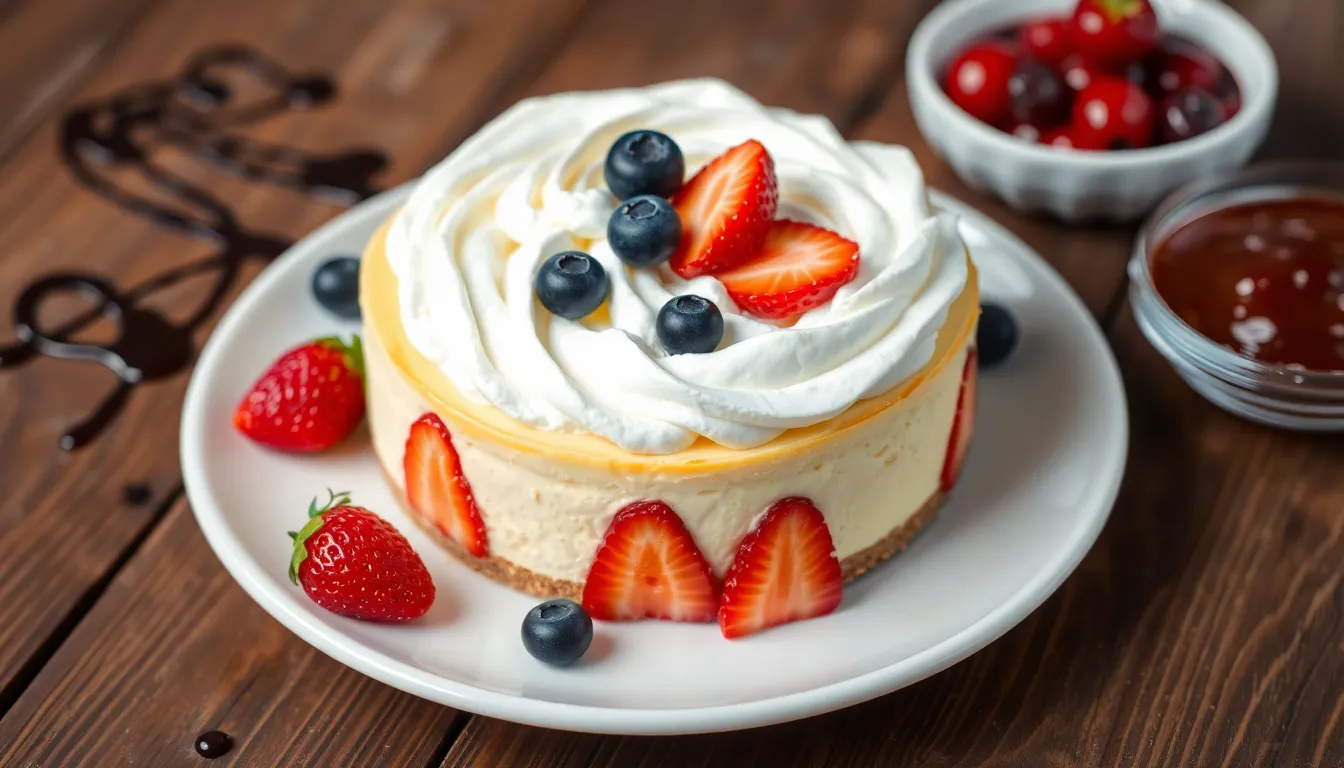
Our small batch cheesecake transforms into an elegant dessert with the right presentation and accompaniments. We recommend allowing the cheesecake to come to room temperature for 15-20 minutes before serving to enhance its creamy texture and allow the flavors to fully develop.
Whipped Cream elevates each slice with vanilla bean whipped cream spooned generously on top. We prepare this by whipping heavy cream with a touch of vanilla bean paste until soft peaks form. The delicate vanilla flavor complements the tangy richness of our cheesecake without overwhelming its signature taste.
Fresh Fruit Toppings provide a refreshing contrast to the dense cheesecake texture. Strawberries and blueberries work exceptionally well as they balance the sweetness with natural acidity. We arrange fresh berries in decorative patterns across the surface or create a colorful medley around each individual slice.
Cherry Pie Filling offers a classic pairing that transforms our mini cheesecakes into bakery-style desserts. The sweet-tart cherries create visual appeal with their deep red color while adding textural variety. We spoon a generous dollop over each mini cheesecake just before serving to maintain the contrast between the smooth filling and chunky fruit topping.
Chocolate Drizzle turns our vanilla cheesecake into an indulgent treat. We melt dark chocolate with a small amount of heavy cream to create a glossy sauce that pools beautifully around each slice. This addition works particularly well with our graham cracker crust variation.
Seasonal Presentations allow us to customize our small batch cheesecake throughout the year. Spring calls for fresh strawberry slices and mint leaves. Summer berries create vibrant color combinations. Fall brings opportunities for caramel sauce and chopped pecans. Winter presentations shine with pomegranate seeds and a light dusting of powdered sugar.
Individual Plating showcases our mini cheesecakes perfectly when we place each one on a dessert plate with artistic sauce drizzles around the base. We use squeeze bottles to create professional-looking designs with fruit coulis or chocolate sauce. A single mint sprig or edible flower completes the restaurant-quality presentation.
Troubleshooting Common Issues
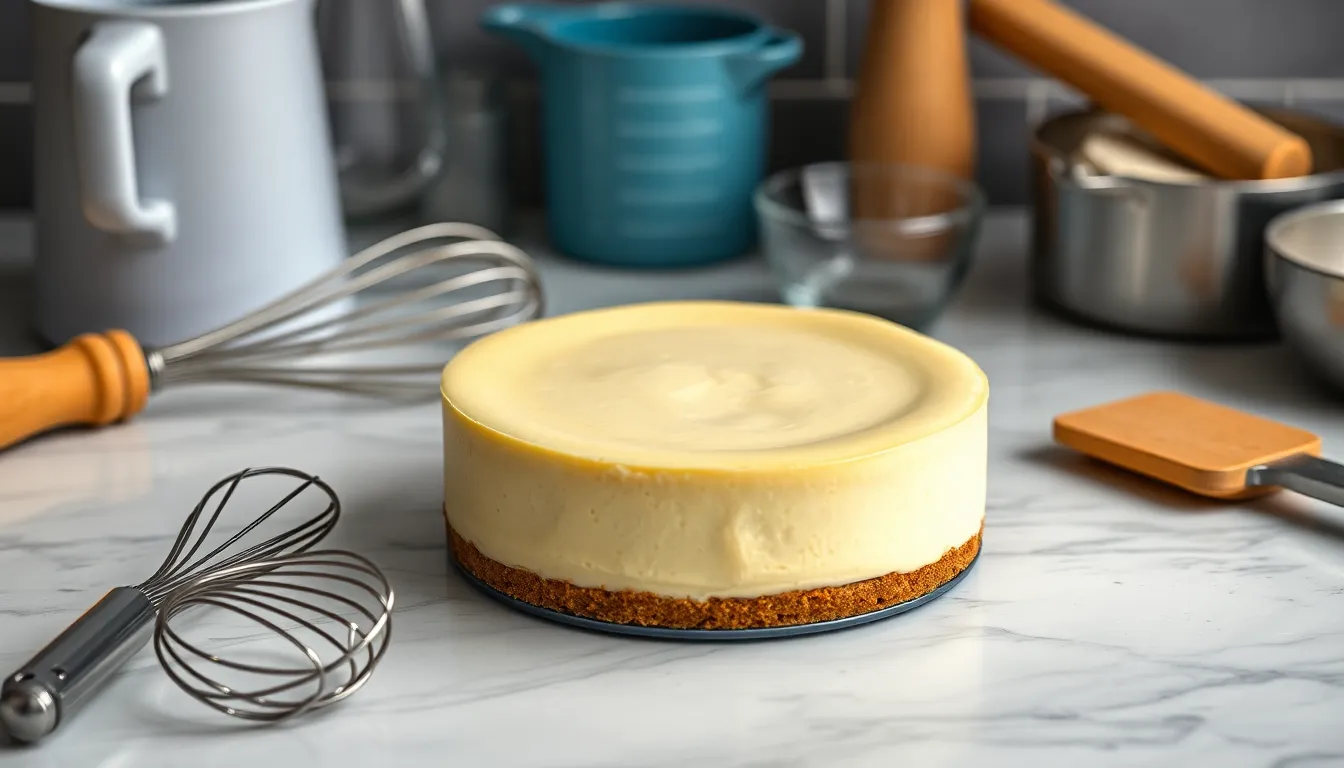
Even experienced bakers encounter challenges when making small batch cheesecakes. We’ve compiled the most common problems and their proven answers to help you achieve perfect results every time.
Preventing and Fixing Cracks
Cracking remains the most frequent issue we see with small batch cheesecakes. Several factors contribute to this problem including overmixing the batter, baking at temperatures that are too high, or cooling the cheesecake too rapidly.
Temperature Control Answers:
- Reduce your oven temperature to 325°F instead of 350°F for gentler baking
- Create a water bath by placing your springform pan in a larger roasting pan filled halfway with hot water
- Allow the cheesecake to cool gradually at room temperature before refrigerating
Mixing Technique Adjustments:
- Use room temperature cream cheese to minimize the mixing time required
- Beat ingredients just until combined rather than whipping extensively
- Avoid opening the oven door during baking to prevent temperature fluctuations
Solving Pan Sticking Problems
Nothing frustrates us more than a beautiful cheesecake that won’t release cleanly from the pan. This issue typically stems from insufficient pan preparation before adding the filling.
Proper Pan Preparation:
- Spray your 6-inch springform pan thoroughly with cooking spray
- Line the bottom with parchment paper cut to fit exactly
- Apply a light coating of butter to both the bottom and sides for extra insurance
Fixing Crust Complications
A crumbly or soggy crust can ruin an otherwise perfect small batch cheesecake. We find that most crust problems relate to improper preparation or insufficient binding.
Crust Success Strategies:
| Issue | Cause | Solution |
|---|---|---|
| Crumbly crust | Not enough butter | Use at least 4 tablespoons melted butter |
| Soggy bottom | Underbaked crust | Pre-bake crust for 8-10 minutes at 375°F |
| Uneven texture | Large crumb pieces | Process graham crackers until finely ground |
Food Processor Method:
- Pulse graham crackers until they form fine, uniform crumbs
- Mix thoroughly with melted butter until the mixture holds together when pressed
- Press firmly into the pan bottom using the bottom of a measuring cup
Resolving Texture Issues
Split or curdled cheesecake filling creates an unappetizing texture that we can easily prevent with proper ingredient management.
Temperature Management:
- Remove cream cheese from refrigeration 2-3 hours before mixing
- Keep double cream or heavy cream cold until ready to use
- Test cream cheese temperature by pressing gently with your finger
Mixing Order Protocol:
- Beat cream cheese alone first until completely smooth
- Add sugar gradually while mixing on medium speed
- Incorporate eggs one at a time, mixing just until combined
Water Bath Troubleshooting
The water bath method prevents many common cheesecake problems, but improper execution can create new issues.
Water Bath Best Practices:
- Wrap the bottom of your springform pan with aluminum foil to prevent water seepage
- Use hot tap water rather than boiling water to avoid shocking the batter
- Maintain water level at halfway up the sides of the cheesecake pan throughout baking
We recommend checking these troubleshooting steps whenever you encounter issues with your small batch cheesecakes. Most problems have simple answers that improve with practice and attention to detail.
Conclusion
Small batch cheesecake transforms the way we approach this beloved dessert. By scaling down traditional recipes we can enjoy fresh homemade cheesecake without the commitment of feeding a crowd or dealing with leftovers that lose their appeal over time.
The beauty of this approach lies in its flexibility and control. We can experiment with premium ingredients and unique flavor combinations at a fraction of the cost while mastering essential techniques on a smaller scale. Whether we’re planning an intimate dinner party or simply treating ourselves to something special the individual portions create a more refined dessert experience.
With proper equipment quality ingredients and attention to detail we can achieve that signature silky texture and rich flavor that makes cheesecake irresistible. The faster baking and cooling times mean we can satisfy our cravings sooner while the make-ahead options provide convenience for busy schedules.
Small batch cheesecake proves that sometimes the best things really do come in smaller packages.
Frequently Asked Questions
What is small batch cheesecake?
Small batch cheesecake is a scaled-down version of traditional cheesecake that serves 2-6 people instead of 12-16. It’s perfect for couples or small families who want to enjoy homemade cheesecake without dealing with excessive leftovers. These mini cheesecakes maintain the same rich, creamy texture and flavor as full-sized versions while offering better portion control.
What equipment do I need for small batch cheesecake?
The essential equipment includes a 6-inch springform pan for proper portion size and structure, a food processor or hand mixer for smooth batter, and a roasting pan for the water bath method. The water bath helps maintain moisture and prevents cracks during baking, ensuring professional results every time.
What ingredients are required for small batch cheesecake?
Key ingredients include full-fat cream cheese, granulated sugar, one large egg, vanilla extract, and optional lemon juice for the filling. For the crust, you’ll need graham cracker crumbs and melted butter. Using room temperature, premium full-fat ingredients is crucial for achieving the signature silky texture and rich flavor.
How long does small batch cheesecake take to bake?
Baking times vary by size: mini cheesecakes require 22-25 minutes, while larger 6-inch versions need 35-45 minutes at 325°F to 350°F. The cheesecake is done when the center has a slight jiggle. After baking, allow gradual cooling at room temperature before refrigerating for best texture.
How should I store small batch cheesecake?
Store the completely cooled cheesecake in an airtight container in the refrigerator for up to 4-5 days. For longer storage, wrap tightly and freeze for up to 3 months. Always protect from air exposure to prevent drying out and maintain optimal texture. Remove from refrigeration only when ready to serve.
Can I make small batch cheesecake ahead of time?
Yes! Prepare the graham cracker crust up to 24 hours in advance and store at room temperature. You can also mix the filling a day ahead and refrigerate until ready to bake. For best results, bake the cheesecake the day before serving to enhance flavor and texture development.
What are some popular flavor variations?
Popular variations include chocolate cheesecake with cocoa powder and melted dark chocolate, berry swirl with fruit compote, and lemon cheesecake with fresh lemon juice and zest. You can also experiment with different crusts like Oreo cookies instead of graham crackers for unique flavor combinations.
How do I prevent cracks in my cheesecake?
Prevent cracks by baking at the correct temperature (325°F-350°F), using a water bath for consistent moisture, and allowing gradual cooling. Ensure ingredients are at room temperature and mix gently to avoid incorporating too much air. Never open the oven door during baking to maintain stable temperature.
What toppings work best with small batch cheesecake?
Popular toppings include vanilla bean whipped cream, fresh berries, cherry pie filling, chocolate drizzle, and fruit compotes. Allow the cheesecake to come to room temperature before serving for optimal flavor. Seasonal toppings and individual plating techniques can create an elegant presentation for special occasions.
Why choose small batch over full-size cheesecake?
Small batch cheesecake eliminates waste, offers better portion control, and allows for experimentation with premium ingredients at lower cost. It’s perfect for couples, small families, or intimate gatherings. These smaller portions also bake and cool faster than traditional recipes, making them more time-efficient for busy schedules.

